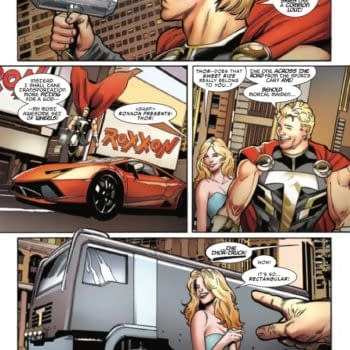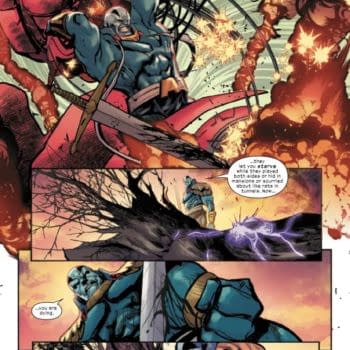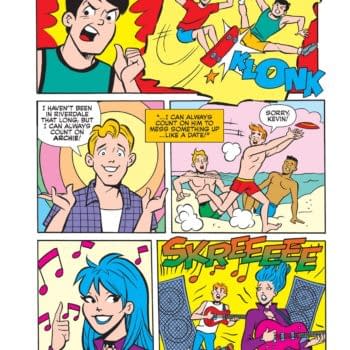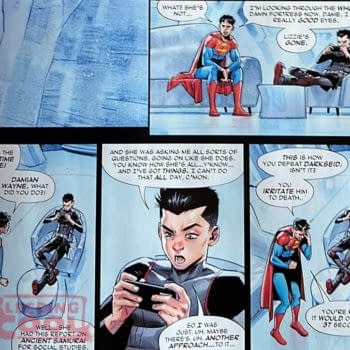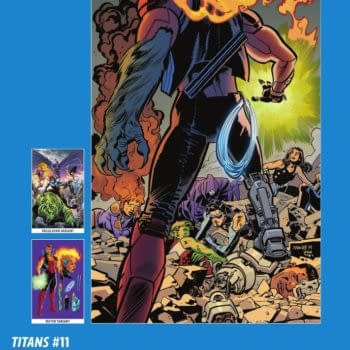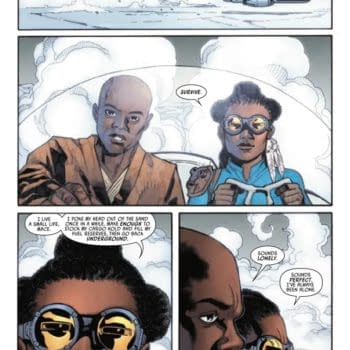Posted in: Comics, Recent Updates | Tagged: Broodhollow, Chainsawsuit, Comics, entertainment, indie Comics, Kris Straub, Mikey Neumann, penny arcade, webcomics
Broodhollow, Chainsawsuit, Horror And Webcomics: Talking With Kris Straub
By Patrick Dane
Kris Straub has been working in the webcomics industry since the turn of the century. In internet time, that's quite a while. If the world wide web was as old as the Earth, he'd have started writing when the super-continent Columbia formed (Trust me, I did the math). In that time, webcomics have grown to become their own form, using a variety of comedy and narratives. They come in many shapes and sizes and now inhabit a valuable space in the internet culture. Some are complicated and high concept, others are simple stick men telling jokes. They are deceptively simple to make, but incredibly hard to master. In that way, it's easy to see them as the new version of the newspaper 'funnies'.
Kris occupies both worlds with his webcomics, currently running two strips concurrently. Chainsawsuit is is a simply drawn humour based comic where as Broodhollow is a narrative driven horror with several striking art styles. He's also a distinct personality outside of his comics as he's made a point of putting himself out there. From his older video series Blamimations and Kris and Scott's Scott and Kris Show, to his current work with Mikey Neumann on the Chainsawsuit podcast, Kris has transcended cartoonist and become an online personality.
Having just finished the second book run of Broodhollow, I caught up with Kris just prior to talk too him about both of his comics, webcomics in general and the role of horror in his (as well as my) life.
Without further ado, please do read on!
Patrick Dane: Where did Broodhollow come from? I find a lot of webcomics end up feeling 'Seinfeldy', just saying "Hey, what about that new iphone?" but Brood Hollow is something very different.
Kris Straub: I dunno…I think I've moved past it (that sense of humour) as a structure or as a constraint, but I remember having a concerting thought. The first webcomic I did was called Checkerboard Nightmare which was about making fun of other webcomics. It didn't stand on its own legs, it stood on other people's legs. Other people did work, I made fun of that work and then I called that my work. Then with Starslip, I wanted to get away from that, but even Starslip is kind of tongue in cheek, pastiche. You know, part of its task is to call attention to the ridiculousness of certain Sci-Fi conceits. Like, why would you have a school on the Enterprise, that type of thing. But, I got all of that out of my system and that ended up being more of a story in and of itself.
Now, I'm here at … let me make a pure thing that someone else can make fun of if they wanted too. Where there is no hint of self-satire, self-awareness or whatever.
PD: How did you go about structuring Broodhollow as an entire narrative?
KS: Um…gosh, that is a great question.
I have a very broad arc for the whole series, which I imagine would take me 5 books…although I wouldn't put a 5 book cap on it necessarily, because I don't actually know what I am going to do after the third one. We are coming to the end of the second one now. But as far as the structuring and the pacing, I come from a standpoint of wanting to produce a really good self-contained book as opposed to a slave to a daily update where every single update has to have a punchline.
Which I love and I think is super important, but there are some people complaining recently…well, there was only one, but of course I will expand that number in my mind. "They all hate it!" They said, and I've seen the complaint before in Broodhollow and they are like, "Well, I wish you would post the entire thing at once, because I hate to wait and if I'm busy, it is supposed to be 3 days a week, but because we have the baby (Kris is a new father), it is tough. So if two weeks go by and there have been only 4 or 5 strips and we are still in the same scene, people are like "How long are we going to spend here? A month?" But all I care about is that when you get it in book form, that is 5 page turns That is barely any time at all and it will feel appropriate. But reading update to update is probably excruciating right now.
PD: You said there is a 5 book plan, but when you sat down to write each episode, did you have plan for what each was going to be?
KS: No…I did not know. I knew big pieces, but Jerry Holkins (Penny Arcade) has been very good to me. He likes to play in other people's universes. In the first book I knew I wanted to have… there had to be some secrets society, but I wasn't going to bring it up until the next book, because I thought we had plenty to do here. But he pushed hard and he said, "No, put it in." He had so much input on adding that in. He has been great to talk to about it. But it is true from the way I had written it, I had no plan to put that in at all. Now it is a pretty big part of the first book. A substantial part of the first book. That is going to let me do stuff, a little bit in this book, which I would have just gotten to. I would have been slower for sure.
PD: It has been going on for a while, so how do you continue to find stories and keep the process fresh for yourself?
KS: Here at the end of Book 2, that is a question I'll rewind the recording of this and just think at the edge of a flowing river….How do I keep it fresh for myself?…I think that what makes Broodhollow special is that it feels very clean to me and it feels very pure in a way that I didn't know that that is how it would turn out. In my mind, I've never described myself as a horror person. I've never described myself as someone who likes that kind of supernatural, whatever.
My first exposure to horror were these old H.P. Lovecraft paperbacks that my dad left around the house. I'd read them when I was like 12. I knew what I liked in there and what I didn't. But there is such a stigma around horror, because horror was always associated with slasher movies, which I don't like, with gore and blood. Broodhollow Book 2 certainly has more of that than the first one did, but I think it is nice to explore different types. But I don't take pleasure out of blood pouring out of somebody.
To go back to your question, I think what keeps it fresh, is that it resonates with me very strongly. I thought Starslip was my thing because it was very much science fiction. A lot of the ideas that I had in Starslip I had in junior high. I thought, "Oh, I have found a home for them now." The stuff in Broodhollow though, the stuff that is in there are my fears but perpetuated up. Those go back to childhood. Those go back further. I thought, Oh, I dunno. I like horror, I'll try that out. Then it started pouring out as I thought, "Oh yeah, I thought about this a lot. A lot more than I would give myself credit for.
PD: Yeah, that kind of horror was a big part of my childhood too.
KS: Where did it come from?
PD: My mother mostly. She entertained the ideas of ghosts and the paranormal in a safe space.
KS: Yeah, my mom did the same stuff. Still does I think. It wasn't outright, not like "oh, there is a ghost here." But it has more to do with superstition. You know, "well, lets do this and make sure we don't… how do you know know that that's helping?" "Well, I've done it, but it works every time. I've never had trouble before when I do it before I leave the house." That really resonated with me. I don't even know if I'd describe my mom as superstitious… Well, I guess I would, but it is low level. To me, it is not a thing that leaps out, but in some ways that make it more insidious though. It's just below the surface. These things that make people make decisions like that. I think you can see a lot of that in the main character of Broodhollow because of his OCD.
PD: What does Chainsawsuit offer you as a series?
KS: Chainsawsuit started when I was…there was a meme, a cool thing to do if you were a cartoon artist back in 2008, and it was 'make 200 bad comics. At the time there were a lot of comics… I was a snob. Such a grouch. I was like, "I'm a cartoonist, that is all I want to be, I've tried so hard and practised so much" and then XKCD and Dinosaur Comics came out. At the time, I couldn't look past the art. Their both super funny and interesting and I couldn't look past the art. I got all grouchy like, "well, I'm a real cartoonist"
So with those two things I decided I was going to do a comic, so I am going to do 200 things. Partly to thumb my nose at it and partly because I want to try, lets see what that is like. Then I got through the 200 and by the end of it, me being a bitter douchebag about it had fallen away and I thought this is fun, and I like it, and I see the value in it. But I had run into so many circumstances in Chequerboard Nightmare and Starslip that, well, less Chequerboard Nightmare, these are comics that have these constraints, like I can't do the joke like the Seinfeld thing you mentioned. I certainly couldn't do it in a sci-fi setting. I tried it a couple times and was like, "you know in the 21st century Britney Spears was considered…" You always had to couch it in "oh, this is historical for them." You can't do that that many times. It gets old.
But yeah, Chainsawsuit became a home for funny things I couldn't fit anywhere else.
PD: Why do you think three panels is most conventional form for a webcomic?
KS: I think it is the smallest form towards the punchline. What I mean by that is three panels, the comedy rules of threes. Three is the smallest number you can have that establishes a pattern and then break it. You need the first two to build the normal scenario and then you need the third to flip it and make it funny, hopefully. That is why I think three is such a traditional…like it is a mathematical construct. We have an expectation that once I show you the first two, you know what to expect. That is just how our brains work. Does that answer you question??
PD: It was a pretty general question. It is probably the best you could have answered it.
KS: Don't get down on yourself. It was a great question [laughs ].
PD: Well, don't get down on your answer, it was a great answer.
KS: Well, now we both have mutual admiration.
PD: You've been around for a while, how have you seen the form change over time and where webcomics are today.
KS: You know? I don't think it has changed as much as I thought it would, but there has been a lot of stuff that…I used to follow quite a bit of the formalism of webcomics discussion and that type of thing like Scott McCloud. The thing about Scott McCloud was that he was right. It may have just been a little too early for me to internalise it, which I guess makes him an even better futurist. But all the stuff he said was coming came, like Patreon and that kind of thing. Even with format stuff, because I'm thinking about webcomics that you can't do on the page, like some of he webcomics have animations or something like Homestuck where depending on what day it is you might get an update that is only animation. You might get an update that is interactive in some way, but I think that we enjoy, we still enjoy being able to hold stuff in our hands, we still enjoy paper. That is why the majority of webcomics will stick to that format.
I'm kind of answering this as a politician because I've been away from actively reading webcomics for so long that I don't know what they are doing. There is one I know I was intrigued by called Ava's Demon. I don't know the name of the author [It's Michelle Czajkowski], but there are animations in the panel and it looks amazing and it is all painted. I feel like that is stuff that is super exciting, where they are now trying to do something different. We've seen, we know what the panels look like. I hemmed myself in a little bit with Broodhollow because I was like, "I like TinTin, I like that 20s and 30s artstyle. I'm just going to do that."
[One of the most recent Penny Arcade strips refencing Mr. Straub]
PD: You've dealt with Patreon and Kickstarter before and a lot has been said about crowd-funding, but how have you found using that model? How do you make sure you are constantly providing and getting to that standard for you audience?
KS: Well, I don't. I just think of them as trash and I just do as I want and take their money. (Laughs) No. It's hard. It's hard. After just having the baby, I felt a lot of guilt over, "Oh, I'm not updating as much as I want." The saving grace that I don't ever want to lean too hard on…I mean you can look at as an example of any product being made that you personally dislike.
You look at it and you are like, "How could people ever spend money on that when there is so many better things to put it on?" But they like it. That's why they are doing it. They're doing it because they like it and you aren't allowed to tell them what they should or shouldn't like. In terms of Patreon, in this difficult. The last 7 or 8 weeks for me (referencing his newborn), people have been lenient and are like, "That's okay, we understand." Now, people aren't always going to be lenient and some people are like *whispers* "I kind of need more than this to keep going". I try to have 3 or 4 posts in Patreon every week if I can, but it is totally understandable. As long as they are enjoying the thing they are enjoying, you can't really come after them.
PD: You've also done a bunch of stuff on video with Blamimations and the Kris and Scott show. What compels you to… this is going to sound so wanky writerish…get out from behind the panel?
KS: [Laughs] Because I like all kinds of humour. There is stuff in video and audio that you just don't have the opportunity to explore on a page. It just doesn't work. I like stuff that does incorporate some animation like that, but I like to go all pure and in one direction. I do the Chainsawsuit podcast with Mikey Neumann which we've done for 74 epsiodes now with one every week. It is such a playground in the way that Chainsawsuit comic is a playground where you can explore different formats and different conceits.
You can make a joke work on paper if you need it too, but nothing is going to replace a timing gag. If you can work one in and you can record your voice and you can make that feel authentic to me, that is such a great road to different kinds of humour.
PD: If you'd like to check out Kris's work, I highly recommend checking out his website here. There you can check out, Chainsawsuit, Broodhollow and all his previous work. If you read an want to donate a little to Kris's production check out his Patreon.
Patrick Dane, once a would be filmmaker, has somewhat accidentally found himself as an entertainment journalist over the past two years. You may recognize him from around these parts, or you may not. Who's counting? From E3 to SDCC to the Top Gear track, Patrick has explored the world of entertainment wherever it has taken him. He is always happy to talk words at you. Hopefully the ones above will suffice your needs.


![[Image 1]](https://mlpnk72yciwc.i.optimole.com/cqhiHLc.IIZS~2ef73/w:600/h:222/q:75/https://bleedingcool.com/wp-content/uploads/2014/10/Image-114.jpg)
![[Image 2]](https://mlpnk72yciwc.i.optimole.com/cqhiHLc.IIZS~2ef73/w:600/h:240/q:75/https://bleedingcool.com/wp-content/uploads/2014/10/Image-2.png)
![[Image 3]](https://mlpnk72yciwc.i.optimole.com/cqhiHLc.IIZS~2ef73/w:auto/h:auto/q:75/https://bleedingcool.com/wp-content/uploads/2014/10/Image-31.png)
![[Image 4]](https://mlpnk72yciwc.i.optimole.com/cqhiHLc.IIZS~2ef73/w:600/h:300/q:75/https://bleedingcool.com/wp-content/uploads/2014/10/Image-49.jpg)








